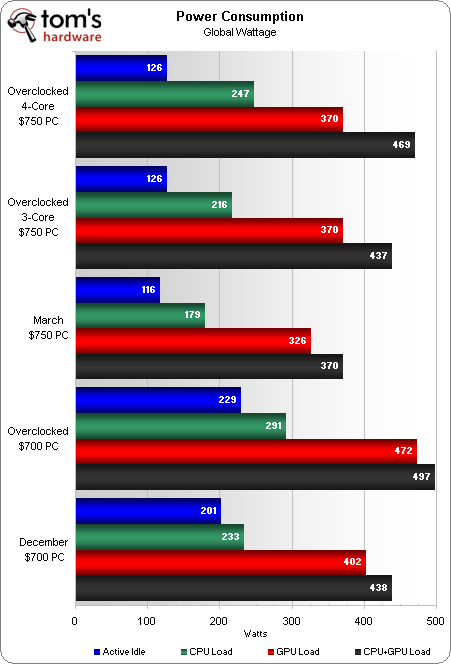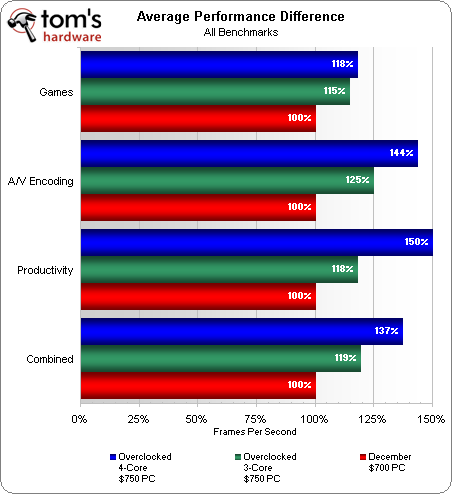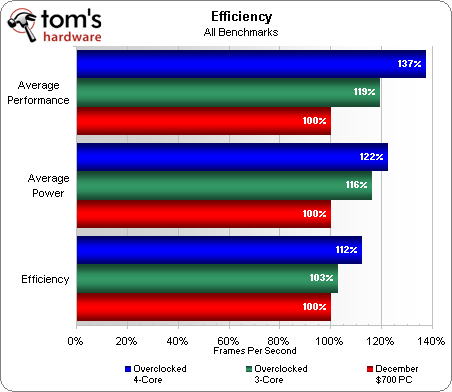System Builder Marathon, March 2010: $750 Gaming PC
Power Consumption, Performance Summary, And Efficiency
For all testing of these value systems, power-saving features were disabled and Windows 7’s power options were set to high performance. Keeping this in mind, let’s take a look at the total system-power usage measured from the AC source.
We normally see excellent power-consumption numbers for a dual-core Wolfdale processor, but the pair of Radeon HD 4870s used in December drastically impacts both idle and load consumption. Also utilizing an Antec EA650W power supply, the March PC consumes less energy while generally offering far better performance. Interestingly, at idle or with just a single CPU core loaded in FurMark, the unlocked quad consumed exactly the same power as the slightly higher clocked triple-core.
Performance Summary
While our best tweaking efforts only delivered a 15%-18% average performance gain in games, one must consider the already-stellar level of performance this value PC was able to deliver at stock speeds. Had our gaming suite not been updated and results for the stock Pentium E5300 from December been used as a baseline, we’d likely see the average boost far exceed 50%.
Overclocking alone delivers sizeable gains in the encoding and productivity applications, but the successful unlocking of the Athlon II X3 435’s fourth core is what truly steals the show here. Simply put, with the exception of iTunes and Xvid encoding, this system blows away all of the previous dual-core value machines throughout the entire encoding and applications suite. Without question, a new bar has been set for application performance, one that isn’t likely going to be topped with less than four processing cores.
Efficiency
The combination of unlocking and overclocking provides a 37% boost to an already-respectable level of stock performance. Power consumption certainly jumps when all four cores are loaded, but the 12% boost in efficiency based on averages is nonetheless still fairly impressive.
Current page: Power Consumption, Performance Summary, And Efficiency
Prev Page Benchmark Results: Productivity Next Page ConclusionGet Tom's Hardware's best news and in-depth reviews, straight to your inbox.
-
erdinger Good job. I Really like the system and I agree in nearly every decision.Reply
unlocking the forth core and still overclocking to 3.6Ghz is just great! I'm getting jealous because my 4th core is broken.
I'm looking forward to the value comparison. -
cruiseoveride This is almost identical to my build. But I used 2nd hand parts, dual HD4870s and it worked out just less than $600.Reply
4 cores, 3.2Ghz, 13,000 3dmark points.
Great bang-for-buck system. -
stray_gator Apart from a SBM entry, this article also provides reality check regarding the benefits of a fourth core. quite useful.Reply -
jsowoc I find the value comparisons are usually (always?) that the least expensive computer has the most "value", followed closely by the middle computer, trailed by the most expensive setup.Reply
Would it be possible to make a 3-way comparison of systems at the same price (for example, $1000)? One could be an AMD-based system, another an Intel-based, and a third maybe a graphics-heavy monster, or a MicroATX system (to see how much performance you sacrifice to stay in $1000 and fit a small form factor). -
Otus What would by interesting is a round of "upgrade" builds. Set specific budgets for ungrades and add them on top of the hardware from a previous round. That would allow commentary on upgrade paths and also help builders of new rigs.Reply -
Crashman jsowocI find the value comparisons are usually (always?) that the least expensive computer has the most "value", followed closely by the middle computer, trailed by the most expensive setup.Would it be possible to make a 3-way comparison of systems at the same price (for example, $1000)? One could be an AMD-based system, another an Intel-based, and a third maybe a graphics-heavy monster, or a MicroATX system (to see how much performance you sacrifice to stay in $1000 and fit a small form factor).Reply
Except for the CPU cooler, you usually sacrifice nothing to go Micro ATX. Tom's Hardware even did a micro-ATX SBM...where the Core i7 system sucked because it had to use the stock cooler. You can find semi-small micro-ATX cases that fit mid-sized coolers.
Antec also makes a MICRO ATX MID TOWER which REALLY sux since it misses the point of Micro ATX completely, so I don't want to hear about that one.
And of course there's Micro ATX mini-towers with the same layout as full-ATX. You get all the performance of ATX and the big cooler, with a case that's around 14-15" tall. -
jsowoc CrashmanExcept for the CPU cooler, you usually sacrifice nothing to go Micro ATX. Tom's Hardware even did a micro-ATX SBM...where the Core i7 system sucked because it had to use the stock cooler. (...)Reply
My argument was not that they should do a $500-$1000-$2000 comparison of uATX builds - they did this. I was suggesting doing a $1000intel - $1000amd - $1000uATX comparison. -
tigerwraith I still dont understand why they went with 2 gfx cards. Ive seen in a lot of reviews that even the newest games dont always work right off the bat when using Crossfire or SLi, So why not spend the money on a 5770 for this. You get DX 11, Dual to Triple moniters, and passthrough. So say you wanted to build a budget HTPC that could game Id have went with the 5770 or 5830 not only would that be a great cpu to watch on a HDTV but you would only need the HDMI cable to run everything.Reply



